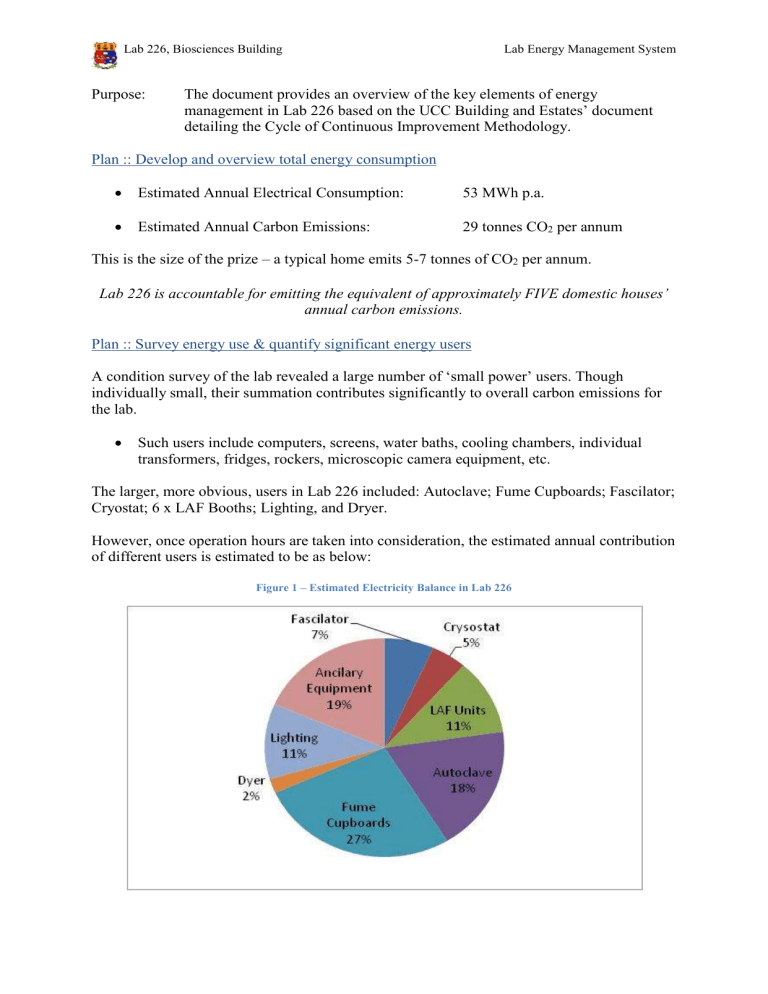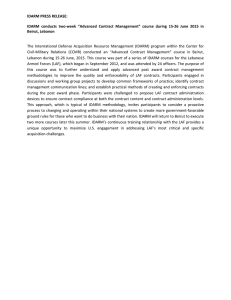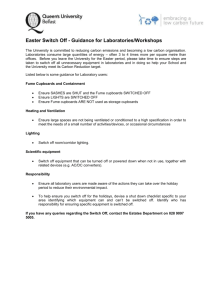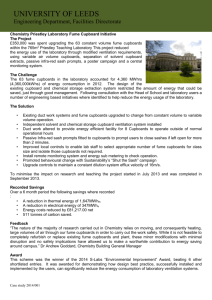Lab 226 Energy Management

Lab 226, Biosciences Building
P
Purpose:
Lab Energy Management System
The document provides an overview of the key elements of energy management in Lab 226 based on the UCC Building and Estates’ document detailing the Cycle of Continuous Improvement Methodology.
Plan :: Develop and overview total energy consumption
Estimated Annual Electrical Consumption: 53 MWh p.a.
Estimated Annual Carbon Emissions: 29 tonnes CO
2
per annum
This is the size of the prize – a typical home emits 5-7 tonnes of CO
2
per annum.
Lab 226 is accountable for emitting the equivalent of approximately FIVE domestic houses’ annual carbon emissions.
Plan :: Survey energy use & quantify significant energy users
A condition survey of the lab revealed a large number of ‘small power’ users. Though individually small, their summation contributes significantly to overall carbon emissions for the lab.
Such users include computers, screens, water baths, cooling chambers, individual transformers, fridges, rockers, microscopic camera equipment, etc.
The larger, more obvious, users in Lab 226 included: Autoclave; Fume Cupboards; Fascilator;
Cryostat; 6 x LAF Booths; Lighting, and Dryer.
However, once operation hours are taken into consideration, the estimated annual contribution of different users is estimated to be as below:
Figure 1 – Estimated Electricity Balance in Lab 226
Lab 226, Biosciences Building
P
Lab Energy Management System
It is noteworthy that the five most significant energy users contribute to 86% of the total lab consumption:
1.
Fume Cupboards
2.
Autoclave
3.
Ancillary Equipment (computers, rockers, baths, fridges, etc)
4.
LAF Units
5.
Lighting
Plan :: Identify and record energy saving opportunities
As the structured energy management activities in Lab 226 are in their infancy, energy saving opportunities should target no-cost ‘housekeeping’ initiatives.
For example:
1.
Ensure Fume Cupboard is turned off outside of normal operational hours
Turning off a fume cupboard for 2 hours every day would reduce the annual carbon emissions by 1.5 tonnes p.a.
2.
The autoclave should only be used when a full load is ready for incineration.
If use of the autoclave is reduced by 5 hours every month, this would reduce carbon emissions by ¾ tonne.
3.
There are a number of computers and screens left running when unattended for extended period. At a minimum, the computer screen should always be turned off. The computer itself should be put in hibernate mode or turned off when left unattended for more than 30 minutes
If 20 computer screens were turned off outside of useful operation, this would reduce carbon emissions by 2 tonne p.a.
4.
Modern LAF do not need a warm up period – accordingly, they should be only turned on as required. The condition based survey identified a number of units left on outside of useful operation.
If one LAF units is left on unintentionally for one day of each week of the year, this contributes to ½ tonne of CO
2
wasted carbon emissions
Do :: Set objectives and targets
The current objective for Lab 226 is rolling out energy efficient housekeeping.
Do :: Establish Programme Plan
Many of the electricity users capable of being operated in an energy efficient manner should be identified in the coming weeks. All lab users should be encouraged to isolate all equipment outside of useful operation.
The encouragement could take the form of stickers and information near all users operated in an intermittent manner (on LAF units, on computer screens, etc).
Lab 226, Biosciences Building
P
Do :: Nominate sufficient human & systems resources
Lab Energy Management System
Nominate an Energy Champion.
This person should liaise with the Building & Estates to gather information to be circulated to lab users in order to encourage energy efficient practices and housekeeping
Check :: Continuously measure & monitor energy performance & check against targets
The checklist outlined below should be filled out and recorded monthly to assess the energy efficiency housekeeping culture.
Check # Descrption
1 Are fume cupboards being left running unnecessarily? (Yes/No)
2 Is the Auotclave only used for full loads? (Yes/No)
3 Number of unattended computers left on (screen or computer)?
4 Number of LAF units running while unattended?
5 Number of lights left on in unoccupied spaces (storage areas, etc)?
6 Is the Cryostat operated efficiently during periods of non-use? (yes/no)
7 Number of small users being operated inefficiently (rockers, baths, etc)?
8 Is the dryer on only when filled with equipment? (yes/no)
Finding
The results will be updated monthly and input to an excel spreadsheet.
Check :: Identify & implement corrective and preventative actions
If the findings of the monthly checks are not in line with the energy champion’s expectations of efficient energy management, the information or encouragement techniques should be refined in order to establish a superior culture.
Act :: Periodically review the Energy Initiatives/Register/Programme and identify improvements
Typically carried out annually, this review of energy management in the lab should examine the success of the previous year’s campaign and identify any further improvements that could be made.











